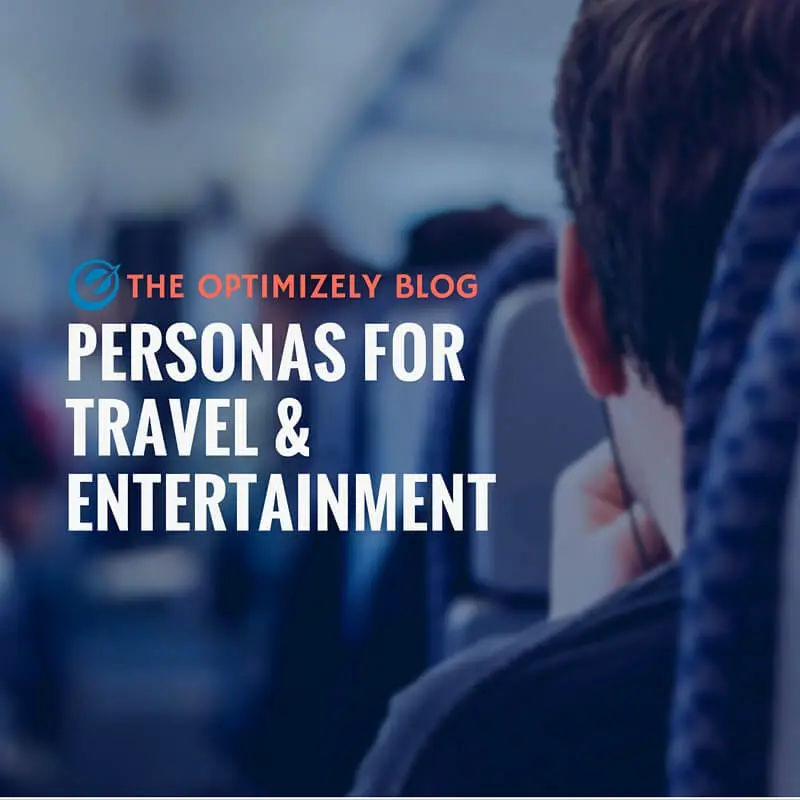The Opportunist vs. The Planner: Personas for Travel & Entertainment Websites
Blue Acorn creates strategies for clients, not industries, an approach that relies heavily on weeks of gathering your customer data.

Matt Rickerby

For the purposes of educating a broader audience, though, we had to take a different approach when designing our upcoming Optimizely webinar on Travel and Entertainment. So we sat down and talked about what we would do if we had to boost online revenue for a set of travel and entertainment sites in just twenty-four hours.
How would we rapidly strategize and launch multiple tests in such a short time frame?
What would we do if we had no time for rigorous data analysis? What assumptions could we safely make about the travel and entertainment industry?
Our optimization strategy is made up of three steps: 1) create personas, 2) define the funnels, and 3) run multiple tests concurrently.
Step 1: Create Personas
To keep things simple, we crafted two personas that exist for both travel and entertainment, but that shop differently on each type of site. That way, we use their similarities while leaving room to adjust for their differences. If you’re not familiar, personas are hypothetical shoppers with their own unique behavioral patterns that marketers use to guide their decisions.
Why create personas? There’s an old joke. Two business owners take their statistician to go hunting. After a few hours of sitting silently in a tree stand, they spot a turkey. The first business owner shoots, but he’s five feet to the left. The second business owner shoots, but he’s five feet to the right. The statistician drops his bow and yells, “We got him!”
Having personas allows us to put a face on our segmented traffic. By referring back to a persona, we can achieve accurate insights and come up with targeted strategies. For example, half of your customers might spend $50 when they shop and the other half might spend $100. If you don’t segment your data, you’ll waste all of your time optimizing your site for your “average” customer; one who spends $75 and doesn’t exist. In other words, when you take aim at the average, you’ll miss.
For our hypothetical scenarios, we’ve organized our travel and entertainment shoppers into two categories: opportunists and planners. Ideally, personas are backed by data. Since we don’t have your data, ours are backed by a small Blue Acorn braintrust. Still, these personas can be a great jumping off point for you and your team.
The Opportunist
 Travel Opportunist
Travel Opportunist
- Has disposable income and is open to traveling at any time
- Is regularly looking for opportunities to escape/get out of town
- Can be motivated by a limited deal or a sense of urgency
- Is maybe looking for some alignment (friends in destination city, favorite artist/sports team playing, has been wanting to see particular place)
Entertainment Opportunist
- Looking to find a unique experience that’s worth their time
- Fear of missing out (FOMO)
- Can be impulsive in preferences and decision-making
The Planner
Travel Planner
- Is more likely to travel for a particular occasion, eg. annual vacation, honeymoon, anniversary
- Needs to be able to assess the full picture
- Will likely be comparing multiple sites and sources
Entertainment Planner
- Needs to be able to iron out the full experience and details
- May need to coordinate friends and accommodate their needs
- Needs more validation to avoid risk of disappointment
Step 2: Define the Funnel

Now that we know who we are solving for, we need to talk about what challenges we’re going to solve. To do that, we need a way to organize them. The most useful way for us to do that is to talk about when they occur. That’s where the funnel comes in. The funnel breaks down the shopping experience into five steps:
- React: This is the landing experience, whether that’s home page or a landing page. Simply put, it’s what people see when the arrive on your site.
- Find: This is the browsing portion of the shopping experience. It includes navigation, category, filtering, and search.
- Choose: This part of the funnel primarily occurs on the product page, when your customers look through product details and review options.
- Buy: Think cart and checkout. Confidence and reduced friction are key here.
- Retain: This is your effort to create repeat business. It starts with the order success page, confirmation emails and follow ups, and ends with a new react phase.
What’s important to your customers will depend on their persona and their place in the funnel. Opportunists and planners will have different needs and challenges at each step and they will be slightly different for each industry. But with each of these defined, we can test better ways to meet those needs and overcome those challenges.
Step 3: Run Multiple Tests
Our conversion consultants have come up with eight test ideas, but to hear them, you’ll have to attend the webinar next week with Blue Acorn and Travel and Entertainment expert, Jay Atkinson. On the webinar, you’ll also hear how you can run several tests concurrently to maximize your gains in a shorter period of time.

